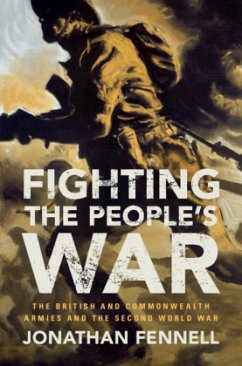Jonathan Fennell
Fighting the People's War
The British and Commonwealth Armies and the Second World War
Jonathan Fennell
Fighting the People's War
The British and Commonwealth Armies and the Second World War
- Gebundenes Buch
- Merkliste
- Auf die Merkliste
- Bewerten Bewerten
- Teilen
- Produkt teilen
- Produkterinnerung
- Produkterinnerung
Jonathan Fennell captures for the first time the true wartime experience of the ordinary soldiers from across the empire who made up the British and Commonwealth armies. He analyses why the great battles were won and lost and how the men that fought went on to change the world.
Andere Kunden interessierten sich auch für
![We Will All Go Down Fighting to the End We Will All Go Down Fighting to the End]() Winston S. ChurchillWe Will All Go Down Fighting to the End6,99 €
Winston S. ChurchillWe Will All Go Down Fighting to the End6,99 €![When Lines Become Crossed When Lines Become Crossed]() Karen VersluysWhen Lines Become Crossed38,99 €
Karen VersluysWhen Lines Become Crossed38,99 €![Leitfaden für britische Soldaten in Deutschland 1944 Leitfaden für britische Soldaten in Deutschland 1944]() The Bodleian LibraryLeitfaden für britische Soldaten in Deutschland 194410,00 €
The Bodleian LibraryLeitfaden für britische Soldaten in Deutschland 194410,00 €![Churchill, Hitler und der unnötige Krieg Churchill, Hitler und der unnötige Krieg]() Patrick J BuchananChurchill, Hitler und der unnötige Krieg29,80 €
Patrick J BuchananChurchill, Hitler und der unnötige Krieg29,80 €![Churchills Friedensfalle Churchills Friedensfalle]() Martin AllenChurchills Friedensfalle22,90 €
Martin AllenChurchills Friedensfalle22,90 €![Britische Feindaufklärung im Zweiten Weltkrieg Britische Feindaufklärung im Zweiten Weltkrieg]() Falko BellBritische Feindaufklärung im Zweiten Weltkrieg66,00 €
Falko BellBritische Feindaufklärung im Zweiten Weltkrieg66,00 €![A Passing Fury: Searching for Justice at the End of World War II A Passing Fury: Searching for Justice at the End of World War II]() A. T. WilliamsA Passing Fury: Searching for Justice at the End of World War II9,49 €
A. T. WilliamsA Passing Fury: Searching for Justice at the End of World War II9,49 €-
-
-
Jonathan Fennell captures for the first time the true wartime experience of the ordinary soldiers from across the empire who made up the British and Commonwealth armies. He analyses why the great battles were won and lost and how the men that fought went on to change the world.
Hinweis: Dieser Artikel kann nur an eine deutsche Lieferadresse ausgeliefert werden.
Hinweis: Dieser Artikel kann nur an eine deutsche Lieferadresse ausgeliefert werden.
Produktdetails
- Produktdetails
- Armies of the Second World War
- Verlag: Cambridge University Press
- Seitenzahl: 966
- Erscheinungstermin: 24. Januar 2019
- Englisch
- Abmessung: 236mm x 164mm x 53mm
- Gewicht: 1650g
- ISBN-13: 9781107030954
- ISBN-10: 1107030951
- Artikelnr.: 53169981
- Herstellerkennzeichnung
- Libri GmbH
- Europaallee 1
- 36244 Bad Hersfeld
- gpsr@libri.de
- Armies of the Second World War
- Verlag: Cambridge University Press
- Seitenzahl: 966
- Erscheinungstermin: 24. Januar 2019
- Englisch
- Abmessung: 236mm x 164mm x 53mm
- Gewicht: 1650g
- ISBN-13: 9781107030954
- ISBN-10: 1107030951
- Artikelnr.: 53169981
- Herstellerkennzeichnung
- Libri GmbH
- Europaallee 1
- 36244 Bad Hersfeld
- gpsr@libri.de
Jonathan Fennell is a Senior Lecturer at the Defence Studies Department at King's College London. He is a Director of the Sir Michael Howard Centre for the History of War and a Director and Co-Founder of the Second World War Research Group. His first book, Combat and Morale in the North African Campaign (Cambridge, 2011) was shortlisted for the Royal Historical Society's Whitfield Prize, was joint runner-up for the Society for Army Historical Research's Templer Medal and was selected as one of BBC History Magazine's 'Books of the Year' 2011.
List of illustrations; List of figures; List of maps; List of tables; Acknowledgements; List of abbreviations; Overview of maps; Introduction; Part I. The Military and Political Context; 1. Interwar: 1.1 Materiel and manpower; 1.2 Doctrine; 1.3 Training and organisation; 1.4 Politics and public morale; 1.5 Structure and contingency; 2. Mobilisation: 2.1 The political context; 2.2 Mobilisation; 2.3 Equality of sacrifice?; 2.4 The social contract; 2.5 Rhetoric and reality; Part II. The Great Crisis of Empire; 3. Defeat in the West: 3.1 The 'Phoney War'; 3.2 The Norwegian campaign; 3.3 The Battle of France; 3.4 Assessments and recriminations; 3.5 Preparing for invasion; 4. The Middle East: 4.1 Operation 'Compass'; 4.2 From East Africa to the Balkans; 4.3 The Battle for Crete; 4.4 Strategic overstretch; 4.5 Operation 'Crusader'; 4.6 Spring 1942; 4.7 Gazala; 4.8 The July battles; 5. The Far East: 5.1 The strategic context; 5.2 Preparations; 5.3 The Malaya campaign; 5.4 The invasion of Burma; 5.5 The fall of Singapore; 5.6 Retreat to India; 5.7 The cost of failure; 6. The great imperial morale crisis: 6.1 The anatomy of defeat; 6.2 Morale crisis; 6.3 The ideological deficit; 6.4 The soldier and the state; Part III. Transformation; 7. Victory in North Africa: 7.1 No retreat; 7.2 Alam Halfa; 7.3 Colossal cracks; 7.4 War Office initiatives; 7.5 El Alamein; 7.6 The Tunisian campaign; 8. New Guinea and Burma: 8.1 The 'Battle for Australia'; 8.2 Kokoda; 8.3 Wau; 8.4 Quit India; 8.5 The Arakan; Part IV. The Limits of Attrition; 9. The Mediterranean: 9.1 Strategy and preparation; 9.2 The Sicilian campaign; 9.3 Opportunity lost; 9.4 The invasion of Italy; 9.5 Advance to the 'Gustav Line'; 9.6 Winter in Italy; 10. Remobilisation?: 10.1 The British Army and the Beveridge Report; 10.2 The New Zealand Furlough mutiny; 10.3 The UDF and the 'Blue Oath'; 10.4 Procedural justice; 11. Cassino: 11.1 Anzio and the First Battle of Cassino; 11.2 The Second Battle of Cassino; 11.3 The Third Battle of Cassino; 11.4 The Fourth Battle of Cassino (Operation 'Diadem'); 12. Transformation in the jungle: 12.1 Training and doctrine; 12.2 Institutional reform; 12.3 The South-West Pacific area; 12.4 Operation 'Postern'; 12.5 Burma; 12.6 Second Arakan; 12.7 Imphal and Kohima; 12.8 Turn around; Part V. Redemption; 13. D-Day: 13.1 Training and doctrine; 13.2 Selection and morale; 13.3 The assault; 13.4 Controversy; 14. Normandy: 14.1 The battle for Caen; 14.2 Operation 'Goodwood'; 14.3 Breakout; 14.4 Encirclement; 14.5 The trap; 15. The victory campaigns: 15.1 Operation 'Market Garden'; 15.2 Operation 'Olive'; 15.3 Manpower crisis; 15.4 The Scheldt and the 'Siegfried Line'; 15.5 Operational and tactical transformations; 15.6 Victory in Italy; 15.7 The surrender of Germany; 15.8 The South-West Pacific area; 15.9 Burma; 15.10 Operations 'Capital' and 'Extended Capital'; Part VI. The Post-War World; 16. Soldiers and social change: 16.1 From combat cohesion to social cohesion; 16.2 The forces vote and the 1945 British General Election; 16.3 The forces vote and New Zealand's great experiment in social citizenship; 16.4 The forces vote and the formalisation of apartheid in South Africa; 16.5 Soldiers, veterans and the partition of India; 16.6 Soldiers, veterans and social change; Conclusion: C.1 A deficit of political legitimacy; C.2 Military performance; C.3 Consequences; C.4 Fighting the people's war; Appendix 1. The censorship summaries; Appendix 2. The morale reports; Appendix 3. Quantitative indicators of morale; Appendix 4. Defining morale; Notes; Select bibliography; Index.
List of illustrations; List of figures; List of maps; List of tables; Acknowledgements; List of abbreviations; Overview of maps; Introduction; Part I. The Military and Political Context; 1. Interwar: 1.1 Materiel and manpower; 1.2 Doctrine; 1.3 Training and organisation; 1.4 Politics and public morale; 1.5 Structure and contingency; 2. Mobilisation: 2.1 The political context; 2.2 Mobilisation; 2.3 Equality of sacrifice?; 2.4 The social contract; 2.5 Rhetoric and reality; Part II. The Great Crisis of Empire; 3. Defeat in the West: 3.1 The 'Phoney War'; 3.2 The Norwegian campaign; 3.3 The Battle of France; 3.4 Assessments and recriminations; 3.5 Preparing for invasion; 4. The Middle East: 4.1 Operation 'Compass'; 4.2 From East Africa to the Balkans; 4.3 The Battle for Crete; 4.4 Strategic overstretch; 4.5 Operation 'Crusader'; 4.6 Spring 1942; 4.7 Gazala; 4.8 The July battles; 5. The Far East: 5.1 The strategic context; 5.2 Preparations; 5.3 The Malaya campaign; 5.4 The invasion of Burma; 5.5 The fall of Singapore; 5.6 Retreat to India; 5.7 The cost of failure; 6. The great imperial morale crisis: 6.1 The anatomy of defeat; 6.2 Morale crisis; 6.3 The ideological deficit; 6.4 The soldier and the state; Part III. Transformation; 7. Victory in North Africa: 7.1 No retreat; 7.2 Alam Halfa; 7.3 Colossal cracks; 7.4 War Office initiatives; 7.5 El Alamein; 7.6 The Tunisian campaign; 8. New Guinea and Burma: 8.1 The 'Battle for Australia'; 8.2 Kokoda; 8.3 Wau; 8.4 Quit India; 8.5 The Arakan; Part IV. The Limits of Attrition; 9. The Mediterranean: 9.1 Strategy and preparation; 9.2 The Sicilian campaign; 9.3 Opportunity lost; 9.4 The invasion of Italy; 9.5 Advance to the 'Gustav Line'; 9.6 Winter in Italy; 10. Remobilisation?: 10.1 The British Army and the Beveridge Report; 10.2 The New Zealand Furlough mutiny; 10.3 The UDF and the 'Blue Oath'; 10.4 Procedural justice; 11. Cassino: 11.1 Anzio and the First Battle of Cassino; 11.2 The Second Battle of Cassino; 11.3 The Third Battle of Cassino; 11.4 The Fourth Battle of Cassino (Operation 'Diadem'); 12. Transformation in the jungle: 12.1 Training and doctrine; 12.2 Institutional reform; 12.3 The South-West Pacific area; 12.4 Operation 'Postern'; 12.5 Burma; 12.6 Second Arakan; 12.7 Imphal and Kohima; 12.8 Turn around; Part V. Redemption; 13. D-Day: 13.1 Training and doctrine; 13.2 Selection and morale; 13.3 The assault; 13.4 Controversy; 14. Normandy: 14.1 The battle for Caen; 14.2 Operation 'Goodwood'; 14.3 Breakout; 14.4 Encirclement; 14.5 The trap; 15. The victory campaigns: 15.1 Operation 'Market Garden'; 15.2 Operation 'Olive'; 15.3 Manpower crisis; 15.4 The Scheldt and the 'Siegfried Line'; 15.5 Operational and tactical transformations; 15.6 Victory in Italy; 15.7 The surrender of Germany; 15.8 The South-West Pacific area; 15.9 Burma; 15.10 Operations 'Capital' and 'Extended Capital'; Part VI. The Post-War World; 16. Soldiers and social change: 16.1 From combat cohesion to social cohesion; 16.2 The forces vote and the 1945 British General Election; 16.3 The forces vote and New Zealand's great experiment in social citizenship; 16.4 The forces vote and the formalisation of apartheid in South Africa; 16.5 Soldiers, veterans and the partition of India; 16.6 Soldiers, veterans and social change; Conclusion: C.1 A deficit of political legitimacy; C.2 Military performance; C.3 Consequences; C.4 Fighting the people's war; Appendix 1. The censorship summaries; Appendix 2. The morale reports; Appendix 3. Quantitative indicators of morale; Appendix 4. Defining morale; Notes; Select bibliography; Index.








